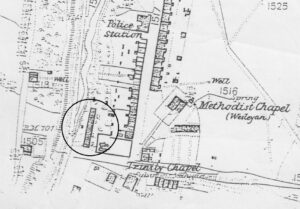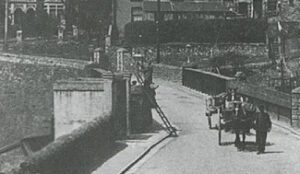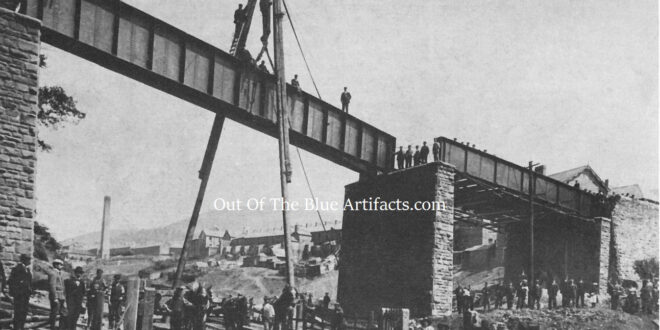The Foundry Bridge Abertillery.
In the 1830’s Abertillery was divided by the River Tyleri, to the east was Cwmtillery and to the west Abertillery. In the 1850’s the lane leading up past the British School to where Alma Street would later be, was called the Parish Road, this was the official dividing line.
In the mid to late 19th century the boundary lines were relaxed and changed, the consensus was that the new dividing line was Division Street and the Rhiw Park level crossing (the place on the railway where the Foundry Bridge would later be constructed, a level crossing to Brynteg) anything above this imaginary line was Cwmtillery and below this was considered to be Abertillery.
The railway station at this time was moved to where the library is now and the entrance to town was from the station up the Bush Hill and past the Globe Hotel. The town and retail center of Abertillery was mainly based around the area between Market Street and Cwm Street. Later the area of Church Street began to build up with a few shops but was considered to be out of the main area. The tradesmen who had premises in the top end of Church Street desperately needed a bridge over the valley to attract shoppers to town from Brynteg, Blaenau Gwent and Penybont, the tradesmen were very vocal and had influence in the affairs of the town besides the Abertillery Local Board.
In the 1880’s the Rhiw Park level crossing was becoming very dangerous with the increasing railway traffic and access to it. From Alma Street down to the railway lines was very steep and slippery, from the crossing up to Division Street was no better and many people travelling to town via this route were getting injured. The only safe route from Brynteg was down to Oak Street, to the station and up Bush Hill, then back, the same route home.
Railway Traffic in 1889.
In February 1889 Mr S. N. Jones urged the local board to consider the placing of some sort of footbridge over the railway by the foundry as quickly as possible, the increasing amount of railway traffic up through the Cwmtillery valley was endangering the population who travelled over the Rhiw Park crossing. In the same month a man was placed on the crossing to monitor activity, throughout the day he observed over 1,000 people passing over the crossing into-and-from town and over the same time period he had logged over 21 trains being shunted up and down the valley.
In March 1889 the Abertillery Local Board instructed the surveyor to estimate the cost of a footbridge over the railway and he informed them that it would cost £135. 6s. 8d. The plan was to place a footbridge or cart bridge over the line to make the crossing of the railway safer for pedestrians.
Many shops were being opened in Brynteg, Penybont and Blaenau Gwent and people had no need to travel to town. The Gray Colliery and the Penybont Colliery with their sidings and congested railway system stopped people crossing the valley further north, the Penybont area had a level crossing between the Old and New Bridgend Inn’s though that was just as dangerous and to journey from the western side of Penybont to town was a long walk. A bridge spanning the valley would allow people from all parts of the west to enter town safely. The surveyor’s estimate of £135 was accepted by the board members and the clerk stated their funds could easily cover the cost though for some unreported reason the need for a bridge was put on hold.
In February 1890 the Abertillery Chamber of Trade held a meeting at the National School, Abertillery. The following member tradesmen were as follows – Mr L. R. Rogers (Presided); Mr J. E. Phillips (Secretary); Mr S. N. Jones; Mr John Ward Williams; Mr Alfred Durrant; Mr A. H. Thomas; Mr Stansfield; Mr Moses Thomas and Mr Wilkins: The need for a bridge cropped up and a parish map was produced and surveyed though it was extremely damaged. Because of this the idea was dropped.
 The Wooden Houses.
The Wooden Houses.
In the mid to late 19th century there was a terrace of six wooden houses in the valley by the side of the River Tyleri (as seen circled in black on the map left from the late 1870’s) just north of Mr John Ward Williams Iron Foundry. These houses may have been built for the workers of the iron foundry in the 1870’s as they were constructed long before the Gray Colliery was sunk and if they were built to house the sinkers of the Tillery Colliery, Penybont there would have been more accommodation and at the time in the mid 1840’s the sinkers came from the Pontypool area and many of them used to travel over the mountain.
In November 1893 these wooden houses were deemed unfit by the Abertillery Local Board and were demolished, it seems they were knocked down to clean up that part of town to make way for a bridge, if one was to be constructed.
The Last Residents of the Wooden Houses in the Tillery Valley.
The last seven families to live in the six properties known as the Wooden Houses in the Tillery Valley were as follows – Number 1 Mr & Mrs William and Elizabeth Jenkins, Mr Jenkins was a colliery haulier and Mrs Jenkins worked in the coke ovens; Number 2 Mr & Mrs James and Sarah Herbert, Mr Herbert was a pit sinker, they had a lodger Mr Thomas Jones who was also a pit sinker; Number 3 Mr & Mrs James and Martha Smith, Mr Smith was a coal miner. There was also another family living at number 3 being Mr & Mrs Thomas and Matilda Edwards, Mr Edwards was a coal miner; Number 4 Mr & Mrs Samuel and Rachael Smith, Mr Smith was a coal miner; Number 5 Mr & Mrs George and Elizabeth Bird, Mr Bird was a coal miner; Number 6 Mr & Mrs John and Catherine Roach, Mr Roach was a coal miner:
In April 1892 the Abertillery Local Board held a meeting, the members who attended were as follows – Mr G. B. Hammond (Chairman); Mr H. J. Phillips; Mr David Lewis; Mr T. Robbins; Mr W. Jordan; Mr J. T. Dawson; Mr J. T. Williams; Mr Joseph Wallace; Mr James Gregory; Dr W. E. Williams (Medical Officer of Health); Mr John A. Shepard (Clerk) and Mr James McBean (Surveyor): There was an agreement between the local board and the G.W.R on the building of the Foundry Bridge and the landowners were informed and in communication with the Abertillery Local Board.
In January 1893 the Abertillery Local Board stated that the building of the bridge would be in progress soon as the legal problems were in hand and the scheme was in the final phase.
The Death of Mr John Ward Williams.
In April 1893 Mr John Ward Williams, iron founder and member of the chamber of trade, passed away which had a great affect on the progress on the bridge scheme.
The Various Landowners.
In December 1893, after twelve months of postponements to the scheme Messrs J. P. Hacquoil & Co of the Powell’s Tillery Steam Coal Company, the landowners, set new terms and conditions. They insisted they would remain the landowners of the area and the sidings etc under the bridge, in return would give the land required for the stone supports for free.
In August 1895 the council were in communication with the Nantyglo & Blaina Company with the intention of purchasing 56 square yards of land costing £10 that was at the bottom of Alma Street on the junction of the proposed bridge.
In December 1895 the land was purchased, given free and plans were agreed to and finalised. The scheme was put into motion.
Tenders.
In February 1896 tenders were invited for the building of the Foundry Bridge and a new road, this new road would later be known as Station Hill.
In March 1896 the tenders of Messrs Gaen Brothers were accepted and the construction began (as seen in the featured image above, the Messrs Gaen Brothers construction team and party) The building project didn’t go as planned and many problems cropped up. There was hardly any news being reported on the progress of the building scheme only that it was taking a long time and that Messrs Gaen Brothers didn’t seem to be in any rush to complete the bridge and road.
In February 1898 at a council meeting Mr Tilney asked for an update on proceedings and was told there was a problem with the girders on the bridge. At the same meeting Mr Tilney instructed the surveyor to go ahead and plant trees along the new road to the bridge, on the banking around the bridge and anywhere else where there were spaces to plant them.
In March 1898 the clerk of the council was requested to write to Messrs Gaen Brothers to finish the bridge and road as quickly as possible. A few weeks later another letter was written to the Gaen brothers as the council believed that the contractors were treating the council with contempt.
In April 1898 the council sanctioned two incandescent arc lamps to be erected one each end of the bridge. Mr W. H. Blackhall the engineer to the Great Western Railway Company complained about the rainwater flowing from Alma Street and surrounding area down the new road and bridge and onto the railway, the property of the G.W.R. The reply from the council was “There was no more water coming from the new road now than there was 10 years previous”. There were drainage outlets from the bridge and also in the large retaining wall on the new road but the water was no more than usual.
The Opening of the Bridge to Foot Passengers.
In August 1898 it was reported that the bridge was open to foot-passengers.
In September 1898 the council placed six lamps on the bridge, two each end and two in the middle.
The Official Opening of the Foundry Bridge.
December 1898 was the date of the official opening of the Foundry Bridge though owing to the long-drawn-out construction it seemed to be a bit of an embarrassment for all parties involved and the opening went without ceremony. This was also the date the three-month “Builders Guarantee, Terms of Work and Maintenance” began.
The Contractor and Architect.
The contractors were as stated Messrs Gaen Brothers of Abertillery and Cardiff.
In January 1899 Messrs Gaen Brothers were given the final payment for the construction of the bridge, pending the production of the final “Engineers Safety Certificate”.
In 1901 the foundry bridge required re-painting with red-oxide paint and tenders were invited for the work. Later in the year the council authorised the work to be done by the surveyor and his own staff.
 The Foundry Bridge Urinals.
The Foundry Bridge Urinals.
In 1902 the urinals on the lower end of the bridge at road level (as seen right) were reported as being exposed and the council gave notice to have them screened from public view.
In October 1908 the foundry bridge was re-painted at a cost of £45 equivalent to £5,130.00 in today’s money. In the following year the tenders of Messrs Hambslett Blue Brick Co Ltd of West Bromwich were accepted for 9s. per dozen of brick copings for the improvements on the bridge.
The Bus Service.
During the 1920’s the omnibus services produced a bus timetable with routes to, and stops at town, as follows – Down from Brynmawr no buses were to stop on the bridge, straight over and to stop outside the Co-operative Store in Church Street, next onto the Abertillery Police Station at Somerset Street. Up the valley, stop at the Abertillery Police Station, Somerset Street, next stop St Michaels Church, Church Street and onto Division Street to park-up and await departure. There was a stop at the bottom of the bridge close to the urinal only on the up route.
The Proposed Alterations of 1930.
In 1930 the council proposed to widen the road in front of the Highbury Club because of the many problems with vehicles mounting the pavement on the dangerous bend at the junction of Alma Street and Gladstone Street. The hill of Gladstone Street was also deemed dangerous and unsafe for the amount of transport entering town from Brynmawr, Blaina and Brynteg.
In November 1931 the council proposed to build a new foundry bridge, although plans were put on hold.
The New Bridge Proposal.
On Monday 30th of March 1936, a monthly council meeting was held, the following members attended – Mr F. Hayes J.P. (Chairman); Mr W. Beynon (Vice Chairman); Mr W. F. Walters J.P.; Mr F. J. Dayton; Mr P. Burchell; Mr G. H. Jones; Mr T. Gale; Mr W. Hodges; Mr W. E. Hardwick; Mr Ivor Morgan; Mr W. Saunders; Mr Godfrey Jones; Mr A. T. Cann; Mr F. Sheen; Mr J. E. Day; Mr W. H. Hillman; Mr D. R. Davies (Clerk); Mr H. J. Williams (Deputy Clerk); Mr Lloyd Robbins (Assistant Clerk); Mr H. Powell (Accountant); Dr T. B. Smith (Medical Officer); Mr F. Padfield (Sanitary Inspector) and Mr D. E. Williams (Rating Officer):
At this meeting a New Foundry Bridge Scheme was proposed. There were two major proposals as follows –
1/ Improvements to the old bridge which involved its widening to 42 feet (2 six-feet walkways, one each side with a 30′ foot roadway through the middle) including the widening of the approaches at the Highbury Corner and Church Street junction.
2/ The construction of a completely new foundry bridge in a different place. The new bridge would be in a direct line from Gladstone Street hill, span the valley and enter Church Street (where the Peacock’s Store is today). Including the compulsory purchase of a few buildings on Alma Street and Gladstone Street to grade the steep hill on Gladstone Street. Mr S. A. Bennett (Surveyor) would consult the Ministry of Transport.
In February 1937 the scheme to construct a completely new bridge was agreed to, plans were prepared, the starting date of July 1938 was announced. Within a few months the council had altered their plans for a new bridge straight across the valley though they stated that they would still build a new bridge, although it would be placed diagonally from Gladstone Street to Tillery and Church Street junction. They would demolish the Highbury and premises on the top of Church Street to make the approaches and angles wider. It was noted that the Abercarn Works were already producing the girder work for its construction.
In July 1938 it was reported that the council had cancelled their plans for the new bridge scheme. The project they approved deemed too costly, it was estimated the new bridge would cost between £27,000-£30,000 exclusive of the purchasing of property to widen the junctions and that the grading of the steep Gladstone Street Hill could not be resolved, it seemed a waste of money.
The New Bridge 1951.
In the early 1950’s a new bridge was eventually built in the same place as the old one only with wider approaches. The new bridge was constructed in 1951 by Mr Robert McAlpine and Sons at a cost of £41,000.
The Official Opening of the New Foundry Bridge 1951.
On Wednesday 18th of July 1951, the New Foundry Bridge was officially opened by Mr Alfred Barnes M.P. the Minister of Transport and Mrs Florence Brown, Chairman of the Abertillery Council.
Description of the New Bridge 1951.
The new bridge was made of pre-stressed sectional concrete, with each section mounted on iron rollers, these rollers rested on plates embedded onto the shoulder of each pillar. The bridge was designed to slightly move along its length to cope with any expansion or contraction. Over the years the bridge deteriorated and needed constant repair to its expansion joints along the road surface.
Following is a Link to – The Second Foundry Bridge 1951.
A New Modern Foundry Bridge Proposal 2007.
In 2007 a new much larger Foundry Bridge was proposed. A short while later the Abertillery Central Club, the Liberal Snooker Club, situated at the lower end of the Foundry Bridge closed, at this time the council purchased the club for themselves to use as a headquarters for the contractors that would be working on the new bridge.
The Start of the New Modern Foundry Bridge 2008.
The groundwork began in January 2008, temporary walkways were installed from Alma Street down into the doctor’s surgery along with traffic diversions along the adjoining streets and roads and work began on the foundations for the new bridge. On Monday 7th of April 2008, the contractors could not get the large crane into Abertillery and work was stopped, as it was deemed too dangerous to proceed. On Wednesday 28th of May 2008 the crane finally arrived, it was sited on the Alma Street side of the valley and construction work resumed.
The Official Opening of the New Modern Foundry Bridge 2009.
In December 2008 the New Modern Foundry Bridge was opened to pedestrians and traffic, as of the completion of the finishing touches like rails and lamps etc it was decided to hold the official opening in the spring of 2009.
The First Car Over the New Foundry Bridge.
The first car to drive across the new Foundry Bridge was driven by Mr Neil Milkins of Arael View, Rose Heyworth, Abertillery. His passenger was Mr Paul Nixey, they drove across the new bridge in a Ford Ka.
The Gaen Brothers.
The following is a Link to – The Gaen Brothers story.
 Out Of The Blue Artifacts A Library of a lifetime of collecting
Out Of The Blue Artifacts A Library of a lifetime of collecting
